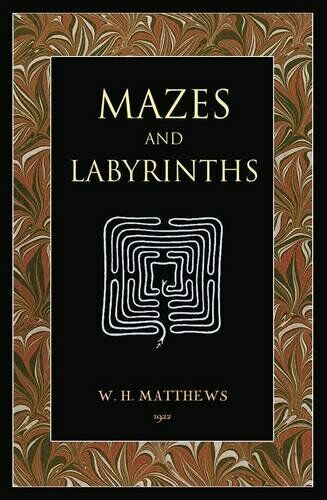Book Review: Mazes and Labyrinths by W.H. Matthews
Humans have long been fascinated by structures that pack the maximum amount of path in a small space, and those that create a puzzle to move through to find a center or exit. This 1922 book was the first major work in English to take a thorough look at the history and locations of mazes and labyrinths.

The author mentions in the introduction that the words “labyrinth” and “maze” have been used so interchangeably over the years that defining a difference between them is a matter for the individual scholar. Sometimes it comes down to which flows better as a name.
The history starts with the ancient world, particularly the Egyptian and Cretan Labyrinths, the latter of course most associated with the tale of Theseus and the Minotaur. Both of these seem to have long since vanished, but there are cave systems and ruins that resemble the fabled confusing structures of yore.
Then it’s up to the church labyrinths of Medieval Europe, embedded in the floors or walls of cathedrals. Later scholars suggested that these were used as ways of making penance for those who could not go on pilgrimages, but as of 1922 no contemporary sources had been found to support this belief. The labyrinths were not generally decorated with Christian symbology, and many had direct visual depictions of minotaurs.
Then it’s on to turf mazes cut into the soil once very common in rural England. These chapters make somewhat sad reading as it mentions maze after maze that has vanished, including one that was destroyed by tanks in World War One.
After that, botanical mazes, both floral ones that do not block your view of other paths, and the topiary or hedge mazes that do. These were huge for English estates back in the day, but considered somewhat passe by the early 20th Century and nowadays confined to a few diehard grounds and parks.
Then stone-built mazes of various places including Finland and Arizona. This is followed by a discussion of why so many labyrinths were named after Troy, the famously impregnable (until Trojan Horse) city. And Rosamund’s Bower, named after an alleged mistress of King Henry the Second, who was kept from the jealous queen by a house (bower} filled with confusing, maze-like passages. It didn’t work, according to legend.
Then it’s time for the etymology of mazes and labyrinths and some thoughts on designing them. The author looks at mentions of labyrinths and mazes in literature, often as metaphors.
The final chapter brings us up to the present of 1922, talking about paper mazes, mirror mazes, and maze toys. This is followed by a bibliography (now considerably out of date) and index. There are copious illustrations showing real and reconstructed mazes that should afford hours of fun if traced.
My reprint of the book by “The Lost Library” preserves the original typeface, which adds to the charm.
This is a thorough look at the subject using the resources available to the author at the time. It’s Anglocentric, so those outside Europe and the classical world who want their own countries’ rich maze heritage acknowledged may need to seek out newer volumes. I found the subject fascinating and the writing engaging when the author wasn’t just listing locations as he sometimes does.
Recommended to bright teenagers on up who enjoy puzzles and games.
Here’s a movie about a maze…

